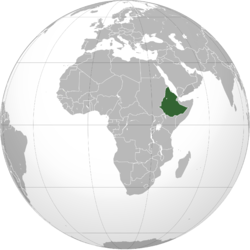
Back የኢትዮጵያ ሕዝባዊ ዲሞክራሲያዊ ሪፐብሊክ Amharic جمهورية إثيوبيا الشعبية الديمقراطية Arabic Народна-Дэмакратычная Рэспубліка Эфіопія Byelorussian Народно-демократична република Етиопия Bulgarian Etiopská lidově demokratická republika Czech Demokratische Volksrepublik Äthiopien German Λαϊκή Δημοκρατία της Αιθιοπίας Greek Popoldemokratia Respubliko Etiopio Esperanto República Democrática Popular de Etiopía Spanish Etioopia Rahvademokraatlik Vabariik Estonian
This article needs additional citations for verification. (November 2023) |
People's Democratic Republic of Ethiopia | |||||||||
|---|---|---|---|---|---|---|---|---|---|
| 1987–1991 | |||||||||
| Anthem: ኢትዮጵያ, ኢትዮጵያ, ኢትዮጵያ ቅደሚ Ītyoṗya, Ītyoṗya, Ītyoṗya, qidä mī (English: "Ethiopia, Ethiopia, Ethiopia be first") | |||||||||
 The People's Democratic Republic of Ethiopia in 1991. | |||||||||
| Capital and largest city | Addis Ababa | ||||||||
| Official languages | Amharic | ||||||||
| Religion | State atheism | ||||||||
| Government | Unitary Marxist-Leninist one-party socialist republic[1] | ||||||||
| General Secretary | |||||||||
• 1987–1991 | Mengistu Haile Mariam | ||||||||
| President | |||||||||
• 1987–1991 | Mengistu Haile Mariam | ||||||||
• 1991 | Tesfaye Gebre Kidan | ||||||||
| Prime Minister | |||||||||
• 1987–1989 | Fikre Selassie Wogderess | ||||||||
• 1989–1991 | Hailu Yimenu | ||||||||
• 1991 | Tesfaye Dinka | ||||||||
| Legislature | National Shengo | ||||||||
| Historical era | Cold War | ||||||||
| 22 February 1987 | |||||||||
| 28 May 1991 | |||||||||
| Area | |||||||||
| 1987[2] | 1,221,900 km2 (471,800 sq mi) | ||||||||
| 1990[3] | 1,221,900 km2 (471,800 sq mi) | ||||||||
| Population | |||||||||
• 1987[2] | 46,706,229 | ||||||||
• 1990[3] | 51,666,622 | ||||||||
| Currency | Ethiopian birr (ETB) | ||||||||
| Calling code | 251 | ||||||||
| ISO 3166 code | ET | ||||||||
| |||||||||
| Today part of | Eritrea Ethiopia | ||||||||
The People's Democratic Republic of Ethiopia (PDRE; Amharic: የኢትዮጵያ ሕዝባዊ ዲሞክራሲያዊ ሪፐብሊክ, romanized: Ye-Ītyōṗṗyā Həzbāwī Dīmōkrāsīyāwī Rīpeblīk) was a socialist state that existed in Ethiopia and present-day Eritrea from 1987 to 1991.
The PDRE was established in February 1987 as a Marxist-Leninist one-party state upon the adoption of the 1987 Constitution, three weeks after approval in the national referendum. The Derg, the military junta that had ruled Ethiopia as a provisional government since 1974, planned for transition to civilian rule and proclaimed a socialist republic in 1984 after five years of preparation. The Workers' Party of Ethiopia (WPE) was founded that same year as a vanguard party led by Derg chairman Mengistu Haile Mariam. The Derg was dissolved with the proclamation of the PDRE, but continued to rule de facto until September when the new government took office, three months after the June general election. It was dominated by surviving Derg members, with Mengistu as both President of Ethiopia and General Secretary of the WPE.[4]
The PDRE's government was highly centralized with a de facto power structure similar to other communist states. The legislature, the National Shengo, was nominally the highest organ of state power. A president served as head of state and head of government, with sweeping executive and legislative powers. The president served as chairman of the Council of State, which acted for the Shengo between sessions. In practice, the principles of democratic centralism meant that the Shengo did little more than rubber-stamp decisions already made by the WPE and its Politburo. As both president and party leader, Mengistu was a virtual dictator. He and the surviving members of the Derg dominated the WPE's Politburo. The constitution guaranteed all manner of personal freedoms, but the government paid almost no attention to them in practice, since the constitution gave citizens no recourse against abuse.
The PDRE inherited issues that ravaged Ethiopia during the Derg era including the 1983–1985 famine, reliance on foreign aid, and the decline of the world communist movement. The Soviet Union ended support of the PDRE in 1990, and internal conflict brought on by the Ethiopian Civil War and Eritrean War of Independence saw the WPE's authority increasingly challenged by ethnic militias and anti-government groups. In May 1991, Mengistu fled into exile. The regime only lasted another week before the Ethiopian People's Revolutionary Democratic Front entered Addis Ababa, dissolving the PDRE and replacing it with the Transitional Government of Ethiopia.
- ^ Brüne, Stefan (1990). "Ideology, Government and Developmentthe People's Democratic Republic of Ethiopia". Northeast African Studies. 12 (2/3): 189–199. JSTOR 43660324.
- ^ "The world factbook". 2010-07-21. Retrieved 2020-04-04.
- ^ "The world factbook". 2010-07-21. Retrieved 2020-04-04.
- ^ Ethiopia Parliamentary Chamber: Elections held in 1995, PARLINE database (accessed 20 October 2009)
© MMXXIII Rich X Search. We shall prevail. All rights reserved. Rich X Search

